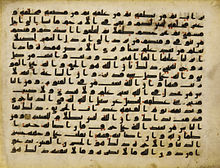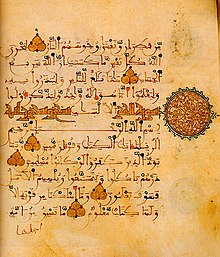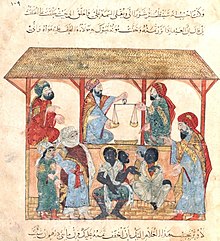Islamic book art

In the history of art, calligraphy , illumination and the art of binding are counted as Islamic book art.
font
In the 7th century, with the Koran , Mohammed brought the Muslim community to the Muslim community the unadulterated revelation of Allah , which was not written by humans and which he himself had received from him.
In the culture of the Arab world, the word plays a particularly important role in spoken or written form. This is why writing is of great importance in Islamic art. Often times it becomes jewelry itself, or ornaments are designed in a manner similar to writing. This is also related to the tendency to avoid pictorial representations.
A font that is frequently used in Islamic art , especially in architectural decor , is Kufi , named after the city of Kufa in Iraq, the alleged place of origin. You can recognize them in their basic form by the strong emphasis on the horizontal, the vertical ascenders of the letters and the overall strict and angular design. This basic form is often modified in its use as an ornament. The braided kufi, in which the ascenders are tied into artistic knots in their middle, is popular. When the tips of the letters end in leaves or stylized flowers, which are usually connected with the surrounding tendrils, one speaks of the blooming kufi.
The basic form of the curved and softer writing forms is the naschī . The individual letters are not arranged as strictly horizontally as in Kufi, their curves and the curved connections between the letters result in a lively typeface.
Another form of the curved script is the Taliq , which is particularly used for texts in the Persian language. The alignment of the individual lines, which slope from top right to bottom left, is striking. The delicate character of this font makes it more suitable for small art. They are less common in architectural decor.
Book art

Books are particularly valued in the Islamic world. The basis for this is the fact that the word of God is conveyed to the believers through the holy book of Islam, the Koran. Therefore, the person who does the godly work of writing, the calligrapher, enjoys special respect for all other artists who are involved in the production of a manuscript. This is clear from the fact that the son-in-law of the Prophet Mohammed and fourth Caliph Ali is traditionally referred to as the first calligrapher.
Even in the oldest surviving Koran manuscripts, parts of the text, such as the beginning of the chapter, are emphasized by different colors, gilding, rosettes, dots and the like. This art of ornamental decoration, the illumination, pervades all book art to this day and is based on the respective temporal and regional style developments.
Miniature painting has been traceable since the Seljuk period. Initially, the representations were relatively small and closely tied to the text they illustrated. Influences from Byzantine , Iranian and Buddhist painting can be clearly seen. Representations of people and animals are part of the repertoire despite the so-called ban on images . In Baghdad at the beginning of the 13th century, a style of painting that was closely linked to the urban sphere flourished, which broke away from the strict forms of the picture structure and preferred other pictorial themes than those of the courtly surroundings.
In the period that followed, Islamic miniature painting not only developed in various regional styles, but also different spheres, such as the painting schools at the courts of the Ilkhan , Timurids , Safavids , Ottomans and the Mughal emperors or commercial book illumination, depending on the client in the area around the bazaar . Over time, the picture became more and more independent from the text, so that eventually many individual pictures were created, which were put together in scrapbooks. The border paintings surrounding a calligraphy or a miniature are a special form of design.
The decoration of the leather book cover developed in close connection with the text illumination and the border paintings. In contrast to the European book, the Islamic binding usually consists not only of the two covers and the spine, but is supplemented by the flap or tongue, which also protects the cut so that the book is completely wrapped. With various embossing, punching and cutting techniques, star braid ornaments and other geometric decorations were initially placed in a rectangular field that was surrounded by a border of braided ribbon patterns or the like. The center of the field became more accentuated over time, and from the 15th century a medallion was used more and more to fill the inner field. Lacquer bindings have been made since the 16th century and were closely based on miniature painting. The art of book binding experienced its heyday especially under the Mamluks in Egypt and Syria, at the courts of the Timurids and Safavids in Iran, the Ottomans and the Mughal emperors .
See also
Web links
literature
- Volkmar Enderlein : Islamic Art . Verlag der Kunst, Dresden 1990. ISBN 3-364-00195-2
- Richard Ettinghausen : Arabic painting. (Series: Die Kunstschätze Asiens) Editions d'Art Albert Skira, Geneva (Klett-Cotta Publishing Association, Stuttgart) 1962, 1979
- Regina Hickmann: Treasures of Islamic Book Art. Edited by Heide and Klaus Koberstein, People and Knowledge, Berlin 1989, ISBN 3-06-171710-2
- Janine Sourdel-Thomine and Bertold Spuler: Die Kunst des Islam Berlin, 1984. (Propylaea art history, 4).
- Thomas Tunsch: Calligraphy and ornament. Islamic handicrafts . In: rulers and saints. European Middle Ages and the encounter between Orient and Occident . FA Brockhaus: Leipzig, Mannheim 1997. (Brockhaus: Die Bibliothek, Kunst und Kultur, 3). Pp. 164-168.
- Thomas Tunsch: Dating and origin of the Mamluk bindings in the Museum of Islamic Art in Berlin. IN: Manuscripta Orientalia 10/1 (March 2004). St. Petersburg 2004, pp. 52-55.
